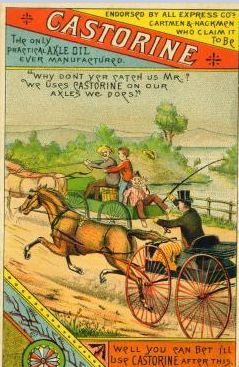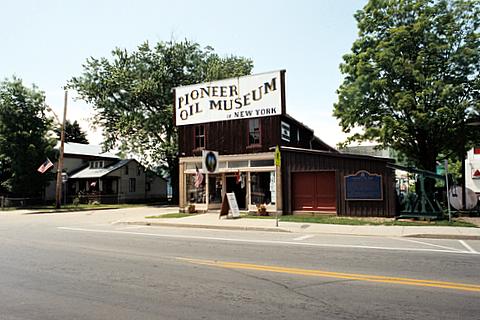Did L. Frank Baum’s 1880s oil business inspire the Tin Man?
The Tin Man in The Wonderful Wizard of Oz can trace his roots to the earliest U.S. oilfields where L. Frank Baum operated a lubricant business before becoming the famous children’s book author.
“Sometimes, when researching history, you find places where it’s still alive,” explained Evan Schwartz in Finding Oz: How L. Frank Baum Discovered the Great American Story.

Before publishing his children’s book in 1900, L. Frank Baum sold a popular axle grease from a company he and his brother founded in 1883.
Schwartz’s search for the oil can of the Tin Woodman led him to discover that in the 1880s, L. Frank Baum and his brother operated a petroleum products business after their father’s success with starting oilfield-related businesses brought the Baum family to Syracuse, New York.
The future author of the children’s novel The Wonderful Wizard of Oz sold cans of buggy wheel and axle oils when he and older brother Benjamin operated a successful Syracuse venture offering lubricants — and Baum’s Castorine, the Great Axle Oil.

L. Frank Baum — whose father found success in Pennsylvania oilfields — served as chief salesman for Baum’s Castorine Company of Syracuse, New York.
Reporting on the July 9, 1883, opening, the Syracuse Daily Courier newspaper noted that Baum’s Castorine was a rust-resistant axle grease concoction for machinery, buggies, and wagons. The axle grease — with its added castor oil — was advertised to be “so smooth it makes the horses laugh.”
Baum’s Castorine Company prospered with Frank serving as superintendent and chief sales representative for the next four years. The upstate New York business was less than 300 miles from Titusville, Pennsylvania, where the first U.S. oil well had been drilled in 1859.
Tin Woodman
As the 20th century approached, L. Frank Baum spent much of his time visiting small towns to market the brothers’ oil products, according to a 2011 exhibit at the Kalamazoo Valley Museum in Michigan. The exhibit also noted, “On one of these trips, while installing a window display for a customer, the idea of the Tin Woodman came to him.”

L. Frank Baum’s sales trips influenced Oz. “On one of these trips, while installing a window display for a customer, the idea of the Tin Woodman came to him.”
The former exhibit at the Kalamazoo Valley Museum also explained that although the Baum petroleum lubricating products enjoyed some success, the original business, “came to an end when the bookkeeper gambled away the profits.”
Baum himself wrote of the Baum’s Castorine Company, “I see no future in it to warrant my wasting any more years of my life in trying to boom it.”
The frustrated businessman sold the business, which by 1879 had new owners — and is still doing business in 2024 as Baum’s Castorine Company. In May 1900, the former oil products businessman published the first of his 14 Oz children’s books, The Wonderful Wizard of Oz, which was followed by The Marvelous Land of Oz four years later.
Petroleum Producer’s Son
L. (Lyman) Frank Baum was born in Chittenango, New York, on May 15, 1856, the seventh of nine children of Cynthia Stanton and Benjamin Ward Baum — one of only five of the children to survive into adulthood.
Thanks to Benjamin Ward Baum’s financial success in the newly established Pennsylvania petroleum industry, the young Baum grew up in an environment where his imagination and love of reading flourished.
In 1860, just one year after America’s first commercial oil discovery, Benjamin Ward Baum closed the family barrel-making business to risk his fortune in the western Pennsylvania oilfields. “Frankie” was then only four and a half years old. Productive oil wells drilled near Titusville and Cherry Tree Run would bring his enterprising father great wealth.
“Benjamin recognized a splendid opportunity and joined the crowds who moved in to exploit the oilfields and develop the area. A hundred new wells were drilled every month, ingenious mechanical contrivances were invented, towns and cities were built,” wrote Katharine M. Rogers in her 2002 book L. Frank Baum, Creator of Oz: A Biography.
“Benjamin began acquiring oilfields, including a particularly profitable one at Cherry Tree Run, a few miles south of Titusville,” Rogers reported. “He later bought property between Bradford, Pennsylvania, and Olean, New York, where he helped to develop the hamlet of Gilmour and built a hotel and an opera house.”
As U.S. consumer demand for kerosene lamps skyrocketed, Pennsylvania’s oil region produced the new industry’s earliest tycoons, long before Standard Oil Company (also see the cautionary tale of the Legend of “Coal Oil Johnny”).
By 1862, the elder Baum owned Carbon Oil Company and was a well-established independent oil producer. His success helped finance diversification into dry goods and other mercantile businesses. Son Frank found employment in several of these family ventures as a young man.
When his father purchased the Cynthia Oil Works in Bolivar, New York, Frank operated a retail outlet for a while.

L. Frank Baum’s father once owned an oil company in Bolivar, New York, where a museum today exhibits the region’s extensive petroleum history. Photo by Bruce Wells.
“The Cynthia Oil Works, the first refinery in Bolivar Township, was erected on the Porter Cowles flats at the north end of Bolivar village in 1882,” according to historian Ronald G. Taylor.
“The plant, owned by B.W. Baum & Son, dealers in oil leases and managers of the first opera house at Richburg, was designed as a lubricating oil works and for the manufacture of ship oil of 300 fire test for illuminating on board ships,” Taylor explained.
Although there were nine daily and 18 weekly newspapers published in the oil regions, there no longer was unlimited free enterprise in oilfields. “John D. Rockefeller had moved in and was increasingly controlling distribution,” added Rogers in her book.
“In 1878, Benjamin organized a group of independent producers to break Rockefeller’s grip by building a pipeline from Bradford to Rochester, where the oil could be transferred to tank cars and shipped to refineries in New York and Buffalo.”
Rockefeller’s Standard Oil Company used its influence with the New York Central Railroad and the state legislature to block the planned pipeline. Despite the setback, Baum continued to find success with prolific oil wells in New York.
After almost 30 years in the oil business, Benjamin Ward Baum (1821-1887) died in Syracuse, New York. His petroleum wealth had helped him acquire small theaters in New York and Pennsylvania and permitted his son to pursue writing, publishing journals, and writing for the stage — perhaps setting the stage for Frank’s future fame.
Finding Tin Man’s Oil Can
When historian Evan Schwartz researched his Finding Oz book in 2009, he was surprised to learn of the role petroleum played in Baum’s life — and that the Tin Woodman’s oil can trace its roots to Baum’s Castorine Company.

L. Frank Baum sold his Baum’s Castorine Company in 1888. His many Castorine sales trips may have led to the idea of a Tin Woodman character for his book, illustrated by W.W. Denslow.
“L. Frank Baum sold cans of buggy wheel oil for a living as the co-owner of Baum’s Castorine Company of Syracuse, New York,” Schwartz explained, noting the company’s troubles that led to Baum’s selling it in 1888. Schwartz also discovered the company still manufactured industrial oils and lubricants under the brand name, Baum’s Castorine Company.
“So I visited the current location in Rome, New York, and sat down for a peek into the archives with owner Charles Mowry, whose grandfather was one of the investors who bought the company from Frank Baum himself,” Schwartz wrote.
“The smells of fine lubricant wafted in the air as I perused the collection of historic oil cans and heard the legend of Baum’s magic balms,” he noted. “What if Frank had never sold oil cans? Would we have never met the heartless Tin Man? And in 1939, why wasn’t Baum’s Castorine given the chance to pony up for some choice product placement?”
Learn about the historic Allegheny petroleum industry by visiting the Pioneer Oil Museum of New York in Bolivar.
A Boy’s Oilfield Adventures
In addition to documenting the earliest signs of oil, geologist and historian Ray Sorenson has been a frequent contributor to the Petroleum History Institute (PHI) publication Oil-Industry History, which in 2012 included his paper about an oilfield in Warren County, Pennsylvania.
During his research, Sorenson discovered the long out-of-print Prince Dusty: A Story of the Oil Regions, an 1891 book by Kirk Munroe. It tells the story of a boy’s adventures in the booming Pennsylvania oilfields and now is preserved in the Library of Congress (LOC) juvenile literature collection.
“To my knowledge, this was the first children’s novel based on the oil industry with a plot line that followed in part the Cherry Grove activity,” Sorenson noted, adding the book, “is probably the only publication where a 12-year-old is on the rig floor handling nitroglycerine shots.”
In chapter four, while at a well drilled by his uncle, the young Dusty Prince prevents an explosion as the 20-foot tin tube is filled with nitro, “the color of soft soap, and about as thick as syrup.”
_______________________
Recommended Reading: Finding Oz: How L. Frank Baum Discovered the Great American Story (2009); L. Frank Baum, Creator of Oz: A Biography
(2002); Empire Oil: The Story of Oil in New York State (1949). Your Amazon purchase benefits the American Oil & Gas Historical Society. As an Amazon Associate, AOGHS earns a commission from qualifying purchases.
_______________________
The American Oil & Gas Historical Society (AOGHS) preserves U.S. petroleum history. Please become an AOGHS annual supporter and help maintain this energy education website and expand historical research. For more information, contact bawells@aoghs.org. © 2025 Bruce A. Wells. All rights reserved.
Citation Information – Article Title: “Oil in the Land of Oz.” Authors: B.A. Wells and K.L. Wells. Website Name: American Oil & Gas Historical Society. URL: https://aoghs.org/petroleum-art/l-frank-baum-castorine-oil. Last Updated: July 3, 2025. Original Published Date: June 1, 2005.




